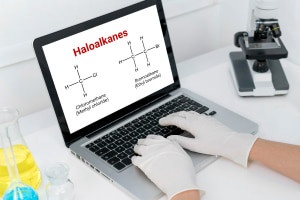Did you know that Teflon is the commercial name for poly(tetrafluoroethylene), which has many applications as a heat-resistant material with nonstick properties? Learn more about Teflon, halothane and other haloalkanes in this chemistry course. We define haloalkanes or halogenoalkanes at the outset, along with their names and the general formula. You'll discover some examples of halomethane compounds and commercial haloalkanes. Then, we move on to the hydrolysis of haloalkanes and the substitution reaction with cyanide. Next, we describe the nucleophilic substitution with ammonia and the mechanism by which substitution occurs. We also review a hydrolysis experiment using silver nitrate to create variously coloured silver halide precipitates.
After that, you'll look at the haloalkane elimination reaction, which results in hydrogen halide loss and a double bond formation. We explain the products of nucleophilic substitution and elimination reactions before exploring the haloalkanes' uses in the industry: Halothane as an anaesthetic and CFCs as aerosol propellants, solvents, and others. Scientists have found that CFCs form free radicals that react with ozone molecules and destroy the ozone layer. The course continues by outlining the characteristics of alcohols, such as their structure, naming rules, and the general formula.
Then, you will learn the three categories of alcohols—primary, secondary, and tertiary—and the number of alkyl groups they have attached to the carbon atom carrying the hydroxyl group. The subsequent subjects covered are the difference in alcohols' boiling points and corresponding hydrocarbons, how the hydrogen bond enables alcohols to dissolve in water, and how the alkyl part enables them to act as organic solvents. We investigate how alcohols undergo complete combustion into carbon dioxide and water and the formation of haloalkane from alcohol. Next, we explore how alcohols undergo elimination reactions and form the corresponding alkenes. Finally, the course discusses the reaction of alcohols with potassium dichromate, distinguishing between primary, secondary, and tertiary alcohols. Start strengthening your understanding of organic chemistry with this course.
What You Will Learn In This Free Course
View All Learning Outcomes View Less All Alison courses are free to enrol study and complete. To successfully complete this course and become an Alison Graduate, you need to achieve 80% or higher in each course assessment. Once you have completed this course, you have the option to acquire an official , which is a great way to share your achievement with the world.
Your Alison is:
- Ideal for sharing with potential employers
- Great for your CV, professional social media profiles and job applications.
- An indication of your commitment to continuously learn, upskill & achieve high results.
- An incentive for you to continue empowering yourself through lifelong learning.
Alison offers 3 types of s for completed courses:
- Digital : a downloadable in PDF format immediately available to you when you complete your purchase.
- : a physical version of your officially branded and security-marked
All s are available to purchase through the Alison Shop. For more information on purchasing Alison , please visit our FAQs. If you decide not to purchase your Alison , you can still demonstrate your achievement by sharing your Learner Record or Learner Achievement Verification, both of which are accessible from your Account Settings.














 Avg Hours
Avg Hours CPD Accredited
CPD Accredited
 Total XP:
Total XP: 
 Knowledge & Skills You Will Learn
Knowledge & Skills You Will Learn







